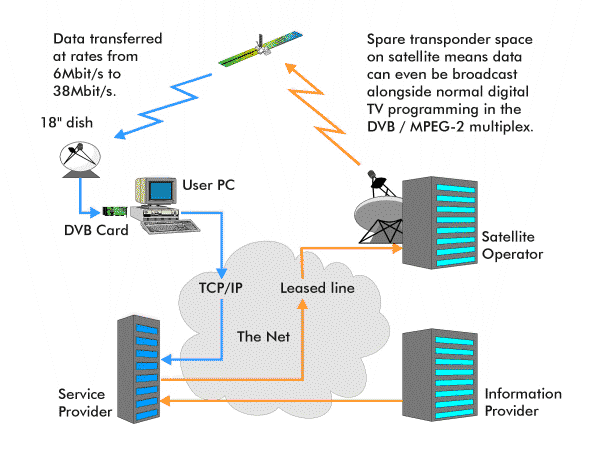
Data Broadcasting
Data Broadcast Networks and Internet over the air
 |
Data BroadcastingData Broadcast Networks and Internet over the air |
In 1997, the DVB Project released its long awaited Data Broadcasting specification. This specification paves the way for high speed data transfer via satellite, cable and terrestrial television channels. Examples of data broadcasting applications include data-casting, downloading software, providing Internet services over broadcast channels, and interactive TV.
The figure below shows how, with a DVB receiver plug-in PC Card, it is possible to use Internet services via satellite, in an application becoming known as "Turbo-Internet".

Figure
1: Turbo Internet uses spare satellite transponders and
PSTN "Return Channels" to deliver high speed TCP/IP data.
For standard 6,7 or 8 MHz TV channels, the DVB standard offers a data throughput potential of between 6 Mbit/s and 38 Mbit/s, depending on whether only a part of the channel or the full channel or transponder is used.
DVB Systems provide a means of delivering MPEG-2 Transport Streams via a variety of transmission media. These transport streams traditionally contain MPEG-2-compressed video and audio. The use by DVB of MPEG-based "data containers" opens the way for anything that can be digitised to occupy these containers.
The DVB Data Broadcasting standard will allow a wide variety of different data broadcasting and interactive services to be implemented, a milestone in digital broadcasting.
DVB-S Satellite transmission of data is much faster than traditional telecommunications methods. For example, a file containing 10 Mb of information normally takes almost 100 minutes to be downloaded over a typical standard telephone modem operating at 14,4 kb/s per second. The same file, via satellite, to a high-end server, will take just 2.2 seconds to download at a bit-rate of 38 Mbit/s. Into a high performance Pentium® PC, it will take 14 seconds, at a speed of 6 Mbit/s.
Various European satellite operators including Astra, Eutelsat, and Hispasat have implemented satellite DBNs. With more than 16 million PCs bought in Europe in 1996, and more than 30 million households having direct access to satellite transmissions, there is already wide acceptance of the standardised technologies involved.
Data-casting or Internet services would typically use a broadcasters’ extra satellite transponder space to broadcast content into the home via the consumer’s 18-inch satellite dish. The received content is then directed to the consumer’s PC via a coaxial cable interfaced with a DVB compliant plug-in PC card. Once decoded, it may be viewed on a browser, or saved on the PCs hard disk for later use.
Where there is a need to have two-way communications, the user connects via the public network to a specific host computer, or to a specific site on the world wide web, for example. At the end user or subscriber end, Conditional Access components built into the PC card integrate with the subscriber management system, allowing the broadcaster to track and charge for the data that every subscriber receives.
The wide area coverage offered by a single satellite footprint ensures that millions of subscribers can receive data in seconds from just one transmission. Since much of the infrastructure is already in place, very little additional investment is needed from both broadcasters and subscribers to take advantage of data broadcasts over satellite.
With possible bit rates of more than 30 Mbit/sec per transponder, a typical CD-ROM could be transmitted to a whole continent in under three minutes. In the future this will be possible over all the DVB delivery media, including cable and digital terrestrial, allowing the data to arrive alongside normal television services.